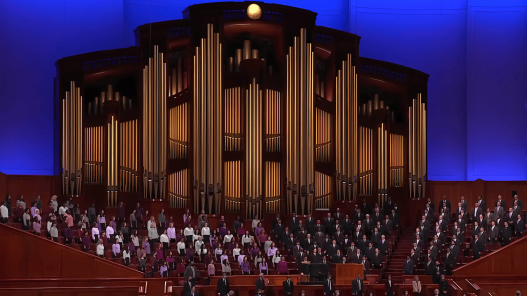William W. Phelps, a key early Latter-day Saint leader and gifted hymn writer, transformed a British Baptist poem into one of the LDS Church’s most cherished anthems.
Phelps masterfully adapted Joseph Swain’s (1761–1796) original poem “O Thou in Whose Presence My Soul Takes Delight,” infusing it with distinctive Latter-day Saint millennial doctrine and perspective.
Freeman Lewis (1780–1859) composed the stirring melody “Dulcimer” (also known as “Beloved” or “Meditation”) that perfectly complements the hymn’s profound message.
This collaboration across time and denominations created “Redeemer of Israel” – a powerful declaration of faith that speaks to Christ’s promised return and Israel’s redemption.
Phelps’ genius lay in honoring Swain’s spiritual foundation while seamlessly weaving in LDS theology, resulting in a timeless anthem that continues to inspire believers with its message of hope and divine deliverance.
About the Song
“Redeemer of Israel” is a hymn written by William W. Phelps in 1832. The song expresses the longing for the return of the Savior and the hope for the restoration of Israel.
It is a powerful declaration of faith, emphasizing the deliverance and redemption that Christ brings to His followers.
The hymn is often sung in religious settings, particularly within The Church of Jesus Christ of Latter-day Saints (LDS Church), where it is cherished for its spiritual depth and comforting message.
“Redeemer of Israel” has become a timeless anthem of faith, reminding the faithful of God’s promise of redemption and the assurance of His return.
| Field | Details |
|---|---|
| Original Author | Joseph Swain (1761–1796) |
| LDS Adapter | William W. Phelps (1792–1872) |
| Music Composer | Freeman Lewis (1780–1859) |
| First LDS Publication | June 1832, Evening and Morning Star |
| Origin of Text | Swain’s poem: “O Thou in Whose Presence My Soul Takes Delight” |
Redeemer of Israel lyrics
Verse 1
Redeemer of Israel,
Our only delight,
On whom for a blessing we call,
Our shadow by day,
And our pillar by night,
Our King, our Deliv’rer, our all!
Chorus
We know He is coming,
To gather His sheep,
And lead them to Zion in love,
For why in the valley
Of death should they weep,
Or in the lone wilderness rove?
Verse 2
How long we have wandered,
As strangers in sin,
And cried in the desert for Thee!
Our foes have rejoiced
When our sorrows they’ve seen,
But Israel will shortly be free.
Chorus
We know He is coming,
To gather His sheep,
And lead them to Zion in love,
For why in the valley
Of death should they weep,
Or in the lone wilderness rove?
Verse 3
As children of Zion,
Good tidings for us,
The tokens already appear.
Fear not, and be just,
For the kingdom is ours.
The hour of redemption is near.
Chorus
We know He is coming,
To gather His sheep,
And lead them to Zion in love,
For why in the valley
Of death should they weep,
Or in the lone wilderness rove?
Verse 4
Restore, my dear Savior,
The light of Thy face;
Thy soul-cheering comfort impart;
And let the sweet longing
For Thy holy place
Bring hope to my desolate heart.
Chorus
We know He is coming,
To gather His sheep,
And lead them to Zion in love,
For why in the valley
Of death should they weep,
Or in the lone wilderness rove?
Verse 5
He looks! and ten thousand
Of angels rejoice,
And myriads wait for His word;
He speaks! and eternity,
Filled with His voice,
Re-echoes the praise of the Lord.
Chorus
We know He is coming,
To gather His sheep,
And lead them to Zion in love,
For why in the valley
Of death should they weep,
Or in the lone wilderness rove?
Themes of The Song
Central themes include hope for Christ’s return, divine redemption, and God’s protective guidance for faithful believers.
- Hope and Divine Redemption: Centers on hope, redemption, and faith in Christ’s return, emphasizing God’s promised deliverance and restoration.
- Longing for Christ’s Return: Expresses deep yearning for Jesus to gather His followers to Zion and free the suffering.
- Divine Protection and Guidance: Portrays God as protector, offering safety and guidance through biblical imagery of “shadow by day” and “pillar by night.”
- Faith Through Adversity: Encourages unwavering faith during trials while anticipating the fulfillment of divine promises.
Through powerful imagery and scriptural symbolism, this timeless hymn continues to inspire believers with its message of hope, redemption, and unwavering faith in divine promises.
Similar Songs
Each song emphasizes unwavering faith, spiritual deliverance, and God’s eternal promises to His faithful followers throughout history. Here are songs similar to “Redeemer of Israel” with themes of faith, redemption, and divine protection.
1. The Spirit of Godby William W. Phelps – This hymn emphasizes faith, worship, and the anticipation of Christ’s return, much like “Redeemer of Israel.”
2. I Know That My Redeemer Livesby Samuel Medley – A song centered around redemption, faith in Christ, and eternal hope, similar in tone and theme.
3. Come, O Thou King of Kingsby William W. Phelps – This hymn expresses longing for the Savior and deliverance, reflecting themes of faith and divine protection.
4. How Firm a Foundation – A traditional hymn (with text by J. Rippon) that focuses on trusting in God’s guidance and protection during trials.
5. All Creatures of Our God and Kingby St. Francis of Assisi (translated by W. H. Draper) – A hymn of praise and reverence for God’s creation and sovereignty, similar in its reverent tone and worshipful nature.
These spiritually enriching hymns complement “Redeemer of Israel” by offering believers additional sources of comfort, inspiration, and strengthened faith in divine promises.
Live Performance of Redeemer of Israel
For more similar hymns about redemption and faith, explore these soul-stirring songs that bring comfort and spiritual strength. You might also enjoy Book of Mormon Stories Lyrics: A Path of Faith for additional inspirational content.
Frequently Asked Questions
Are There Any Interesting Facts About the Hymn’s Original Melody?
Freeman Lewis composed the melody for ‘Redeemer of Israel,’ called ‘Dulcimer.’ While praised for its solemn and uplifting tone, there is no documentation of Lewis’s intent. It evokes reverence and hope.
Can “Redeemer of Israel” Be Performed as A Solo Piece?
Yes, the hymn can be beautifully performed as a solo, though it is often sung in group settings to emphasize its themes of unity and collective faith.
What is the Historical Context Behind the Creation of “Redeemer of Israel”?
The hymn was written in 1832 by William W. Phelps and first published in the Evening and Morning Star in June of that year, during a time of great anticipation within the early Latter-day Saint community as they awaited both spiritual restoration and the return of Christ.














